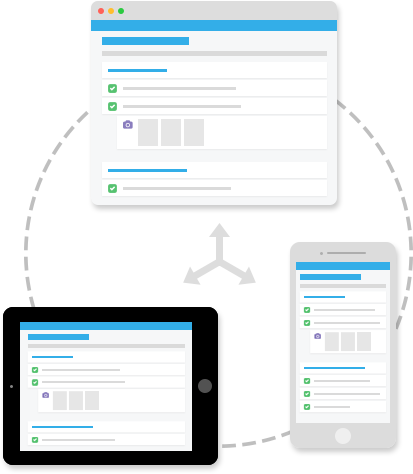Strategies to Mitigate Targeted Cyber Intrusions Checklist
Over 85% of the cyber intrusions ASD responds to could be prevented by following the Top 4 mitigation strategies
- Computer networks are targeted by adversaries seeking access to sensitive information.
- A commonly used technique is social engineering, where malicious 'spear phishing' emails are tailored to entice the reader to open them. Users may be tempted to open malicious email attachments or follow embedded links to malicious websites. Either action can compromise the network and disclose sensitive information.
- The Australian Signals Directorate (ASD) has developed a list of strategies to mitigate targeted cyber intrusions. The list is informed by ASD's experience in operational cyber security, including responding to serious cyber incidents and performing vulnerability assessments and penetration testing for Australian government agencies.
How often should this be used?
Review Annually
Review Annually
Attribution:
Developed from the Strategies to Mitigate Targeted Cyber Intrusions by the Australian Signals Directorate
Library
Categories
Strategies to Mitigate Targeted Cyber Intrusions
Top 4 Strategies
Application whitelisting of permitted/trusted programs, to prevent execution of malicious or unapproved programs including DLL files, scripts and installers.
Patch applications,eg, Java, PDF viewers, Flash, web browsers and Microsoft Office. Patch or mitigate systems with 'extreme risk' vulnerabilities within two days. Use the latest version of applications.
Patch operating system vulnerabilities. Patch or mitigate systems with 'extreme risk' vulnerabilities within two days. Use the latest suitable operating system. Avoid Windows XP.
Restrict administrative privileges to operating systems and applications based on user duties. Such users should use a separate unprivileged account for email and web browsing.
Additional Strategies
User application configuration hardening, disabling the running of internet-based Java code, untrusted Microsoft Office macros, and undesired web browser and PDF viewer features.
Automated dynamic analysis of email and web content run in a sandbox to detect suspicious behaviour including network traffic, new or modified files, or configuration changes.
Operating system generic exploit mitigation mechanisms, eg, Data Execution Prevention (DEP), Address Space Layout Randomisation (ASLR) and Enhanced Mitigation Experience Toolkit (EMET).
Host-based Intrusion Detection/Prevention System to identify anomalous behaviour such as process injection, keystroke logging, driver loading and persistence.
Disable local administrator accounts to prevent network propagation using compromised local administration credentials that are shared by several computers.
Network segmentation and segregation into security zones to protect sensitive information and critical services such as user authentication by Microsoft Active Directory.
Multi-factor authentication especially implemented for remote access or when the user is about to perform a privileged action or access a sensitive information repository.
Software-based application firewall, blocking incoming network traffic that is malicious or otherwise unauthorised, and denying network traffic by default.
Software-based application firewall, blocking outgoing network traffic that is not generated by whitelisted applications, and denying network traffic by default.
Non-persistent virtualised sandboxed trusted operating environment, hosted outside the organisation's internal network, for risk activities such as web browsing.
Centralised and time-synchronised logging of successful and failed computer events with automated immediate log analysis, storing logs for at least 18 months.
Centralised and time-synchronised logging of allowed and blocked network events with automated immediate log analysis, storing logs for at least 18 months.
Email content filtering allowing only business-related attachment types. Preferably analyse/convert/sanitise links, PDF and Microsoft Office attachments.
Web content filtering of incoming and outgoing traffic, whitelisting allowed types of web content and using behavioural analysis, cloud-based reputation ratings, heuristics and signatures.
Web domain whitelisting for all domains, since this approach is more proactive and thorough than blacklisting a tiny percentage of malicious domains.
Block spoofed emails using Sender ID or Sender Policy Framework (SPF) to check incoming emails, and a 'hard fail' SPF record to help prevent spoofing of your organisation's domain.
Workstation and server configuration management based on a hardened Standard Operating Environment with unrequired functionality disabled e.g. IPv6, autorun and LanMan.
Antivirus software using heuristics and automated internet-based reputation ratings to check a program's prevalence and its digital signature's trustworthiness prior to execution.
Deny direct internet access from workstations by using an IPv6-capable firewall to force traffic through a split DNS server, an email server or an authenticated web proxy server.
Server application security configuration hardening e.g. databases, web applications, customer relationship management, finance, human resources and other data storage systems.
Enforce a strong passphrase policy covering complexity, length and expiry, and avoiding both passphrase re-use and the use of a single dictionary word.
Removable and portable media control as part of a data loss prevention strategy, including storage, handling, whitelisting allowed USB devices, encryption and destruction.
Restrict access to Server Message Block (SMB) and NetBIOS services running on workstations and on servers where possible.
User education, eg, internet threats and spear-phishing socially-engineered emails. Avoid weak passphrases, passphrase re-use, exposing email addresses and unapproved USB devices.
Workstation inspection of Microsoft Office files for potentially malicious abnormalities, eg, using the Microsoft Office File Validation or Protected View features.
Signature-based antivirus software that primarily relies on up-to-date signatures to identify malware. Use gateway and desktop antivirus software from different vendors.
TLS encryption between email servers to help prevent legitimate emails being intercepted and used for social engineering. Perform content scanning after email traffic is decrypted.
Block attempts to access web sites by their IP address instead of by their domain name, eg, implemented using a web proxy server, to force cyber adversaries to obtain a domain name.
Network-based Intrusion Detection/Prevention System using signatures and heuristics to identify anomalous traffic both internally and crossing network perimeter boundaries.
Gateway blacklisting to block access to known malicious domains and IP addresses, including dynamic and other domains provided free to anonymous internet users.
Capture network traffic to/from internal critical-asset workstations and servers, as well as traffic traversing the network perimeter, to perform post-intrusion analysis.
We help you and your business

Make ChecklistsItemize your repeatable tasks once - perform them many times.

Document ProcessesProvide detailed documentation alongside tasks.



